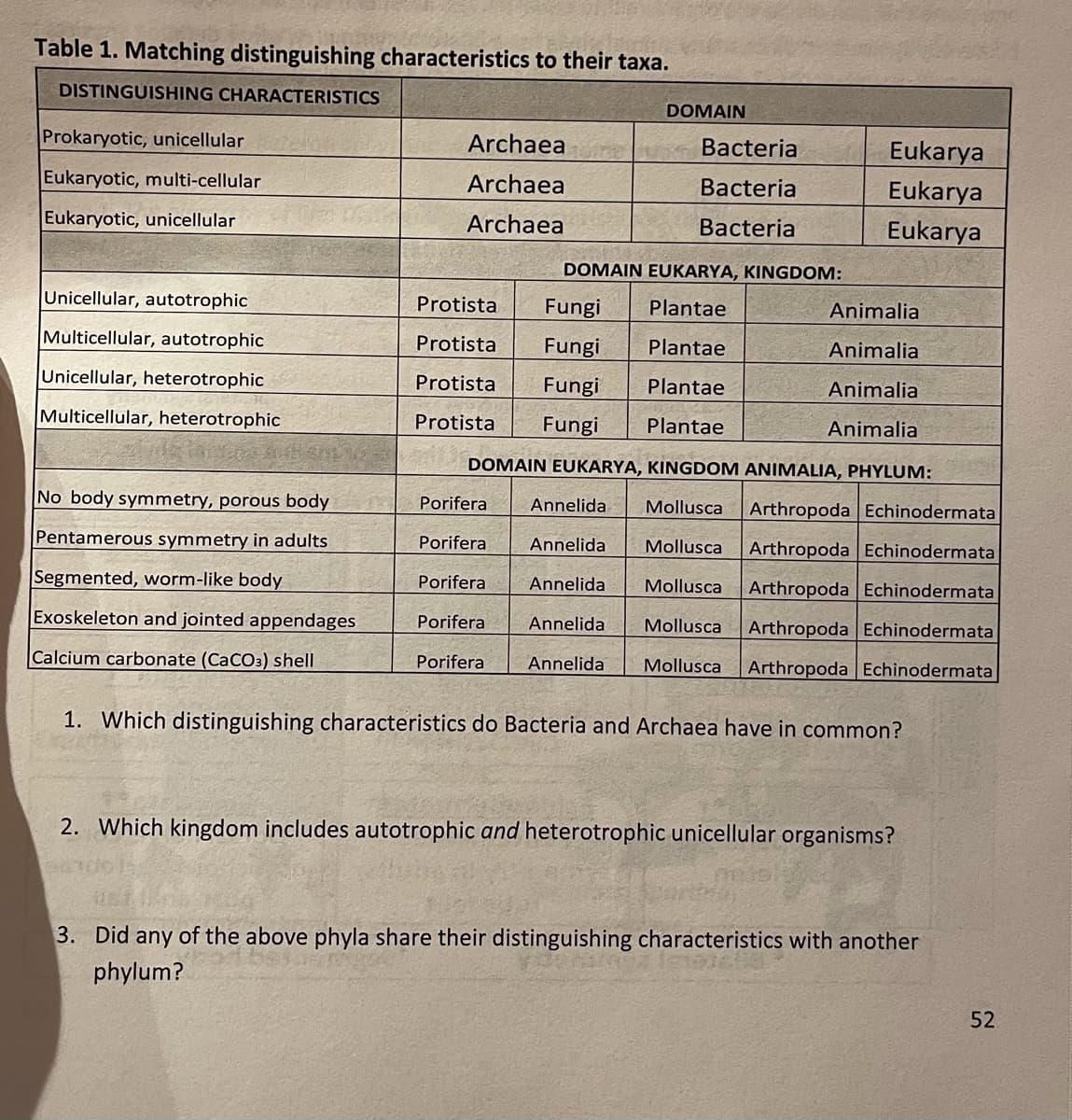Table 1. Matching distinguishing characteristics to their taxa. DISTINGUISHING CHARACTERISTICS DOMAIN Prokaryotic, unicellular Archaea Bacteria Eukarya Eukarya Eukaryotic, multi-cellular Archaea Bacteria Eukaryotic, unicellular Archaea Bacteria Eukarya DOMAIN EUKARYA, KINGDOM: Unicellular, autotrophic Protista Fungi Plantae Animalia Multicellular, autotrophic Protista Fungi Plantae Animalia Unicellular, heterotrophic Protista Fungi Plantae Animalia Multicellular, heterotrophic Protista Fungi Plantae Animalia DOMAIN EUKARYA, KINGDOM ANIMALIA, PHYLUM: No body symmetry, porous body Porifera Annelida Mollusca Arthropoda Echinodermata Pentamerous symmetry in adults Porifera Annelida Mollusca Arthropoda Echinodermata Segmented, worm-like body Porifera Annelida Mollusca Arthropoda Echinodermata Exoskeleton and jointed appendages Porifera Annelida Mollusca Arthropoda Echinodermata Calcium carbonate (CaCO3) shell Porifera Annelida Mollusca Arthropoda Echinodermata 1. Which distinguishing characteristics do Bacteria and Archaea have in common? 2. Which kingdom includes autotrophic and heterotrophic unicellular organisms? 3. Did any of the above phyla share their distinguishing characteristics with another phylum?
Table 1. Matching distinguishing characteristics to their taxa. DISTINGUISHING CHARACTERISTICS DOMAIN Prokaryotic, unicellular Archaea Bacteria Eukarya Eukarya Eukaryotic, multi-cellular Archaea Bacteria Eukaryotic, unicellular Archaea Bacteria Eukarya DOMAIN EUKARYA, KINGDOM: Unicellular, autotrophic Protista Fungi Plantae Animalia Multicellular, autotrophic Protista Fungi Plantae Animalia Unicellular, heterotrophic Protista Fungi Plantae Animalia Multicellular, heterotrophic Protista Fungi Plantae Animalia DOMAIN EUKARYA, KINGDOM ANIMALIA, PHYLUM: No body symmetry, porous body Porifera Annelida Mollusca Arthropoda Echinodermata Pentamerous symmetry in adults Porifera Annelida Mollusca Arthropoda Echinodermata Segmented, worm-like body Porifera Annelida Mollusca Arthropoda Echinodermata Exoskeleton and jointed appendages Porifera Annelida Mollusca Arthropoda Echinodermata Calcium carbonate (CaCO3) shell Porifera Annelida Mollusca Arthropoda Echinodermata 1. Which distinguishing characteristics do Bacteria and Archaea have in common? 2. Which kingdom includes autotrophic and heterotrophic unicellular organisms? 3. Did any of the above phyla share their distinguishing characteristics with another phylum?
Human Anatomy & Physiology (11th Edition)
11th Edition
ISBN:9780134580999
Author:Elaine N. Marieb, Katja N. Hoehn
Publisher:Elaine N. Marieb, Katja N. Hoehn
Chapter1: The Human Body: An Orientation
Section: Chapter Questions
Problem 1RQ: The correct sequence of levels forming the structural hierarchy is A. (a) organ, organ system,...
Related questions
Question
100%
Answer questions 1,2, and 3

Transcribed Image Text:Table 1. Matching distinguishing characteristics to their taxa.
DISTINGUISHING CHARACTERISTICS
DOMAIN
Prokaryotic, unicellular
Archaea
Bacteria
Eukarya
Eukarya
Eukaryotic, multi-cellular
Archaea
Bacteria
Eukaryotic, unicellular
Archaea
Bacteria
Eukarya
DOMAIN EUKARYA, KINGDOM:
Unicellular, autotrophic
Protista
Fungi
Plantae
Animalia
Multicellular, autotrophic
Protista
Fungi
Plantae
Animalia
Unicellular, heterotrophic
Protista
Fungi
Plantae
Animalia
Multicellular, heterotrophic
Protista
Fungi
Plantae
Animalia
DOMAIN EUKARYA, KINGDOM ANIMALIA, PHYLUM:
No body symmetry, porous body
Porifera
Annelida
Mollusca
Arthropoda Echinodermata
Pentamerous symmetry in adults
Porifera
Annelida
Mollusca
Arthropoda Echinodermata
Segmented, worm-like body
Porifera
Annelida
Mollusca
Arthropoda Echinodermata
Exoskeleton and jointed appendages
Porifera
Annelida
Mollusca
Arthropoda Echinodermata
Calcium carbonate (CaCO3) shell
Porifera
Annelida
Mollusca
Arthropoda Echinodermata
1. Which distinguishing characteristics do Bacteria and Archaea have in common?
2. Which kingdom includes autotrophic and heterotrophic unicellular organisms?
3. Did any of the above phyla share their distinguishing characteristics with another
phylum?
52
Expert Solution
This question has been solved!
Explore an expertly crafted, step-by-step solution for a thorough understanding of key concepts.
This is a popular solution!
Trending now
This is a popular solution!
Step by step
Solved in 4 steps

Knowledge Booster
Learn more about
Need a deep-dive on the concept behind this application? Look no further. Learn more about this topic, biology and related others by exploring similar questions and additional content below.Recommended textbooks for you

Human Anatomy & Physiology (11th Edition)
Biology
ISBN:
9780134580999
Author:
Elaine N. Marieb, Katja N. Hoehn
Publisher:
PEARSON

Biology 2e
Biology
ISBN:
9781947172517
Author:
Matthew Douglas, Jung Choi, Mary Ann Clark
Publisher:
OpenStax

Anatomy & Physiology
Biology
ISBN:
9781259398629
Author:
McKinley, Michael P., O'loughlin, Valerie Dean, Bidle, Theresa Stouter
Publisher:
Mcgraw Hill Education,

Human Anatomy & Physiology (11th Edition)
Biology
ISBN:
9780134580999
Author:
Elaine N. Marieb, Katja N. Hoehn
Publisher:
PEARSON

Biology 2e
Biology
ISBN:
9781947172517
Author:
Matthew Douglas, Jung Choi, Mary Ann Clark
Publisher:
OpenStax

Anatomy & Physiology
Biology
ISBN:
9781259398629
Author:
McKinley, Michael P., O'loughlin, Valerie Dean, Bidle, Theresa Stouter
Publisher:
Mcgraw Hill Education,

Molecular Biology of the Cell (Sixth Edition)
Biology
ISBN:
9780815344322
Author:
Bruce Alberts, Alexander D. Johnson, Julian Lewis, David Morgan, Martin Raff, Keith Roberts, Peter Walter
Publisher:
W. W. Norton & Company

Laboratory Manual For Human Anatomy & Physiology
Biology
ISBN:
9781260159363
Author:
Martin, Terry R., Prentice-craver, Cynthia
Publisher:
McGraw-Hill Publishing Co.

Inquiry Into Life (16th Edition)
Biology
ISBN:
9781260231700
Author:
Sylvia S. Mader, Michael Windelspecht
Publisher:
McGraw Hill Education